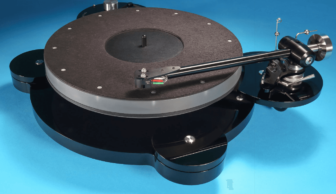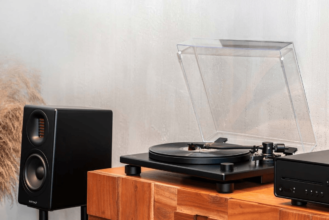Cyrus Audio TTP Turntable Review
Cyrus is known in the audiophile community for powerful, high-quality electronics, including for phono. A long-awaited turntable has finally arrived. The Cyrus TTP is here!
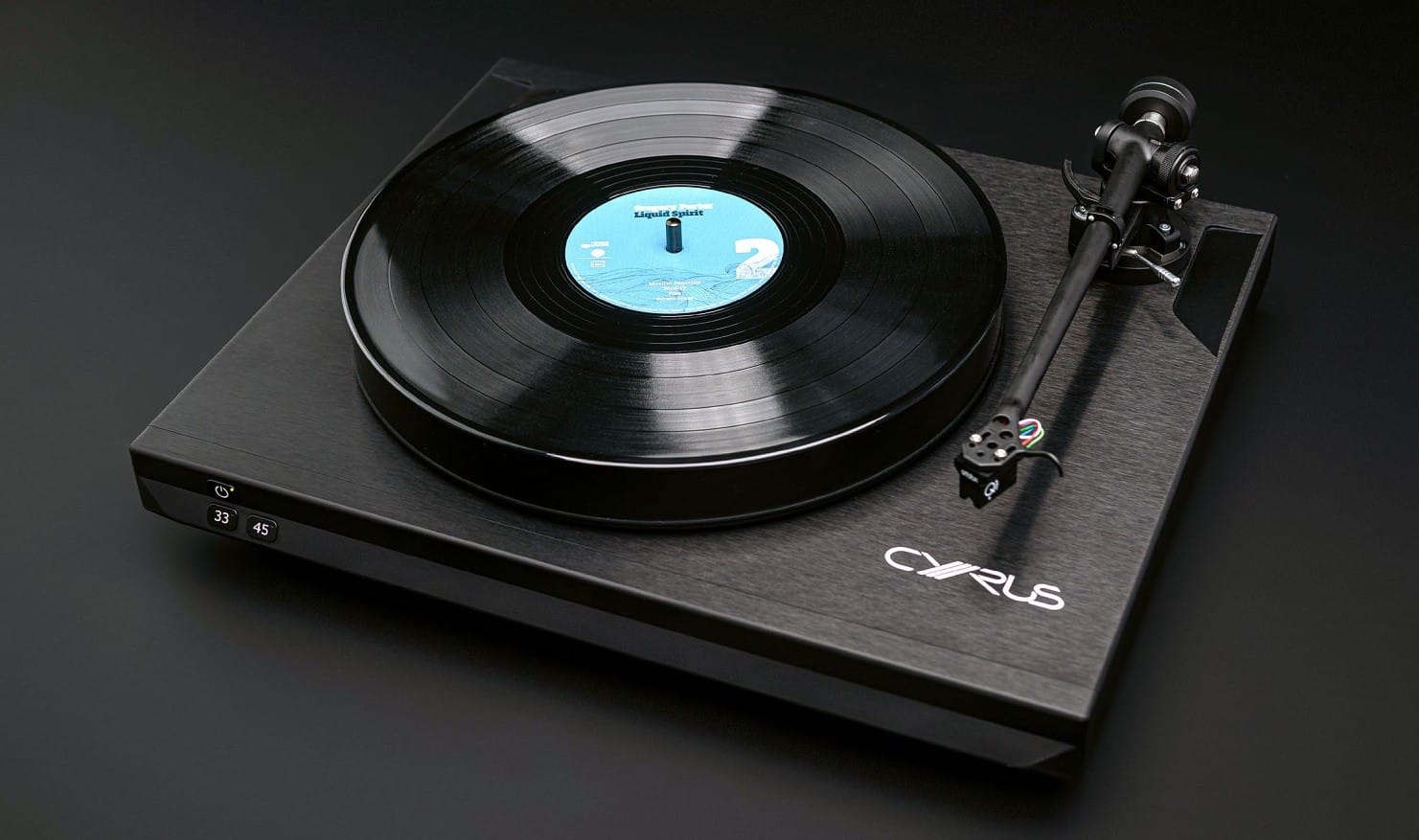
The sensation is perfect: Cyrus, originally founded by the Persian-born brothers Farad and Henry Azima as an electronics subsidiary of the British speaker manufacturer Mission in Huntingdon near Cambridge, later became an independent brand. Since the 1980s, it has been known as a supplier of audiophile midi-components in the distinctive “brick” full-metal case. Now, they have introduced their first turntable, the Cyrus TTP.
This step didn’t come entirely as a surprise, as the two striking phono preamps, aEQ7 and especially Phono Signature, had already set the stage for such a consistent innovation. The electronics showed the high value and importance Cyrus obviously placed on analog music sources.
The appearance of the surprisingly slim, delicate, and fine-looking turntable, which still weighs almost 25 kg, clearly reflects the classic Cyrus design.
High Recognition Value
The brand is instantly recognizable. The transfer of the brand’s essence to the turntable is a tremendous success! In addition to design aspects, the usual materials are also used.
The case supporting the massive platter is, like the platter itself, literally machined from solid, in this case, a solid block of aluminum. Additionally, they opted for an “indirect” belt drive, which is known for its smooth operation and effectively filters out motor vibrations.
Setting up in the large listening room doesn’t take long, as the tonearm is pre-mounted, and the belt and bearing oil are, of course, included. We—namely, veteran Matthias Böde, who is the best and fastest at this—quickly install a Transrotor Merlo Reference cartridge.
While the origin of the tonearm isn’t much of a mystery—any hi-fi fan would recognize it as the OEM version of the well-known and versatile Rega RB 330 from a distance—the identity of the technology partner that helped develop the turntable took a little more thought.
We didn’t know, and Cyrus kept quiet. But since our website also features a test of the flagship turntable from Acoustic Signature, a southern German analog specialist, the mystery is quickly solved. Just look at the platter or the “plucked” leather mat. We think it’s great.
Competent Partner
It’s simple: if you were a renowned electronics specialist taking on a challenging project involving precision mechanics and fine engineering, what would you do? You’d likely seek support from respected experts who aren’t competitors in your existing product range—and that’s exactly what Cyrus did, sensibly. Gunther Frohnhöfer knows his craft.

5,000 euros is certainly an ambitious price—it’s no bargain, especially since you also need a decent cartridge and possibly a phono preamp. However, Cyrus fans—who will be the first to closely examine the TTP—are very loyal. Owners of Cyrus’s specialized phono preamps have undoubtedly been waiting for this turntable, while many current and older preamps and integrated amplifiers (e.g., Cyrus 3i) can immediately operate MM cartridges with this turntable without additional investment.
The medium-weight Rega tonearm is flexible and universal enough to handle even better and more expensive MC cartridges that require higher amplification superbly. This version of the RB 330 features improved geometry with clever mass distribution for resonance optimization, an aluminum tube, reduced bearing friction, a stainless steel counterweight and shaft, and improved adjustment options. The low-capacitance phono cable with high-quality Neutrik plugs is also made by Rega.
In Depth Look
Taking a closer look at the Cyrus TTP, you’ll notice the DC motor, which Cyrus describes as a synchronous motor equipped with a completely new digital control circuit. This is designed to achieve the desired, extremely low speed fluctuations and long-term speed stability. Oscillation effects, like those found in other control systems, should not occur here.

Of critical importance to the smooth operation of a turntable is the quality of the bearing. You can imagine this when you consider the microscopic size of the groove modulations on a record.
Here, the engineers chose a vacuum-hardened stainless steel bearing with precision grinding and plasma coating to significantly reduce friction coefficients. According to Acoustic Signature, the bearing, screwed into the aluminum block, is comparable to that of the Maximus flagship turntable. It’s designed for extreme durability and is generously oversized in the best sense.
»THE CYRUS IMPRESSES IN TERMS OF HANDLING, TECHNOLOGY, AND SOUND!«
Even non-experts can check this. Remove the belt, “spin” the platter, and let it run. A good bearing will continue to rotate for several minutes, and that’s exactly what happens—just don’t forget to put a drop of bearing oil on the stainless steel spindle during setup. The turntable’s performance is excellent. If needed, the speed for 33 and 45 rpm can be finely adjusted with a screwdriver at the back of the device.

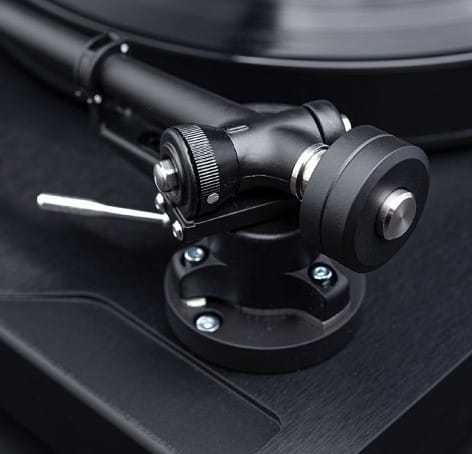
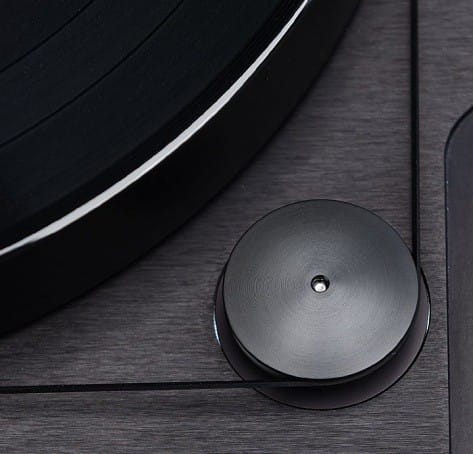

TEST EQUIPMENT
Phono Preamp: Brinkmann Edison MkII
Preamplifier: Audio Research Reference 6SE
Power Amplifier: Krell i400
Speakers: Wilson Sasha V
Cables: Cardas, HMS, Supra
Upgrading Possible
Cyrus fans will be excited about the option to add an external PSX-R(2) power supply, which, like nearly every Cyrus device, can further enhance performance with its ultimate stabilized power supply, even as an upgrade later on. The PSX-R/R2 power supply communicates with the connected device to determine the required voltage, which, for the TTP, is delivered about ten times more precisely and cleaner than with the basic setup. That’s a strong argument, given today’s increasingly polluted power networks due to interference, DC offset, phase cuts, and high-frequency noise.
7Review has repeatedly tested and confirmed the positive sonic improvements of this upgrade on Cyrus CD players and amplifiers over the years. A PSX-R2 power supply currently costs around 1,200 euros. Even in its basic configuration with the external power supply, the Cyrus TTP offers an energy-saving “standby” mode for sustainability and peace of mind. However, the area with the greatest sound improvement potential is the cartridge, as the TTP is shipped without one.
The platter mat, with its dark, carbon-like pattern, actually fulfills its role excellently as soft leather, offering great contact and friction properties with the record. Scratching records with this Cyrus is hardly the point!
A Welcome Addition
The new introduction from Cyrus has been a hit in the market and must be considered a success. This long-overdue analog turntable is truly worthy of the Cyrus name and is already receiving positive reviews from fans and beyond.
We sit down and let Tony Bennett’s voice take over. The recently deceased singer and entertainer, with his unmistakable timbre, captivates the audience even in his later years, with fascinating intonation. The soundstage is almost as good as it gets. Everything is in its place, believable in its dimensions, and very transparently located in the well-lit and lively stage with the band. What a performance!
We switch to Katja Maria Werker, whose Stockfisch album “Mitten im Sturm” is one of the author’s analog highlights. In Peter Gabriel’s cover song, you can literally feel the goosebumps when hearing Werker’s voice and the sparse instrumentation. No exaggeration, and almost endlessly repeatable.
Breathless in the Sweet Spot
With a good turntable in a quality setup—this time, see the box, particularly excellent—you involuntarily feel your arm hairs stand up. Unlike streaming, where you’re always searching for the next track, the analog slow pace lets you listen to the whole side of a record. It’s a ritual, a tactile pleasure that we rarely take the time to enjoy. But it’s pure relaxation.
We reach for the next record. It’s Joe Jackson’s possibly best album, “Night and Day,” featuring two incredible but completely different tracks, “Slow Song” and “Steppin’ Out.” Again, vocals but entirely different. The Cyrus delivers perfectly, with depth, flow, and authority in the presentation. The mix of finesse and muscle is perfectly executed.
There’s a good reason why the author applied for this review. In fact, more than one. As a collector of Cyrus classics, he was eager to meet the TTP. Today’s wishlist just got longer.


WHAT WE LISTENED TO
KATJA WERKER: MITTEN IM STURM

This unique voice has something special, and the sound is outstanding!

JOE JACKSON: NIGHT AND DAY
“Steppin’ Out” is Jackson’s ultimate feel-good song.
Specs
| Product / Price Class | Turntable / 3,000 to 7,000 euros |
| Website | www.cyrusaudio.com |
| Dimensions (W x H x D, in cm) | 43.8 x 7.5 x 39.5 |
| Weight (in kg) | 24 |
| Distribution in Germany | Bellevue Audio, bellevueaudio.de |
| Turntable Type / Drive Principle | Manual / Belt |
| Bluetooth / Connections | No / RCA |
| Integrated Phono-Pre / Cartridge included | No / No |
Verdict

| Category | Weight | Score | Remarks |
| Sound Quality | 60% | 9.4 | Precise, fluid, fast, open, with excellent timing |
| Measurements | 15% | 9.4 | Very low rumble, perfect speed accuracy (0.0% deviation) |
| Features | 10% | 6.8 | No dust cover, good build quality, limited fine adjustments |
| Handling and Operation | 10% | 5.1 | Limited adjustability, manual in English only, no headshell |
| Service and Environment | 5% | 8 | Low power consumption, compact packaging, hard power switch |
Cyrus TTP Turntable and Audio Physics at the Bristol HiFi Show 2024
Cyrus TTP, Audio Physic Avanti
Bristol Hi Fi Show 2024.



